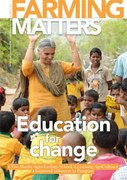The Eastern African Farmer Innovation Fair (EAFIF), held in May 2013 in Nairobi, brought together 50 farmer innovators from Ethiopia, Kenya, Tanzania and Uganda, all of whom showcased their creativity. EAFIF was an attempt to stimulate a social learning process, encouraging those concerned with agricultural research and development (ARD) to engage in joint learning and action.
Planned and organised by a group of governmental and non-governmental agencies in Kenya and co-ordinated by Prolinnova–Kenya and the AgriProFocus (APF) AgriHub, EAFIF was also the launching pad for an international workshop on Agricultural Innovation Systems in Africa (AISA), which had an explicit focus on recognising smallholders as sources of innovation.
In AISA, several initiatives –including Prolinnova, CCAFS, JOLISAA (Joint Learning in Innovation Systems in African Agriculture) and AusAID’s Food System Innovation for Food Security project– tried to gain a better understanding of agricultural innovation processes, focusing on the role of smallholders.
Women and men farmers from the four eastern African countries gave their messages to the AISA participants during the opening session of the workshop, held on the final afternoon of the EAFIF. In this way, smallholders’ voices guided the deliberations on how research, practice and policy can strengthen innovation processes in smallholder farming. The interaction during the EAFIF and the opening session of the AISA workshop was meant to stimulate a social learning process that will link different types of knowledge and lead to joint action.
The AISA participants –mainly scientists and academics– gained insights into how innovation happens in smallholder settings. They recognised the farmers as “creative, innovative and courageous” and wanted to “nurture farmer capacities to do research”. The farmers invited the scientists to collaborate in improving local innovations.
Many participants now want to hold similar events in their home countries. However, it is quite expensive and time-consuming to organise such farmer innovation fairs, and it is not always easy for farmers to take part in them. This raises a number of questions. Are such innovation fairs worth it? Do they really broaden social learning? Are there more effective and less costly ways of stimulating learning among farmers and drawing in other ARD actors in ways that respect farmers’ knowledge and creativity – while also stimulating farmers to value the knowledge of formal scientists?
What other experiences and insights do you have about this? Please write to Ann Waters-Bayer of Prolinnova (waters-bayer@web.de) or to Jorge Chavez-Tafur at ILEIA (j.chavez-tafur@ileia.org). For blogs, photos and videos from the EAFIF, see http://aisa2013.wikispaces.com/farmer+fair

